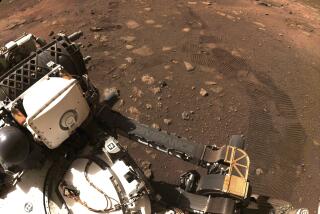Mars rover Opportunity breaks the off-world driving record
Opportunity, the little rover that could, has broken a 41-year-old driving distance record that’s out of this world. The decade-old NASA Mars rover has crossed the 25-mile mark, surpassing the 24.2-mile record held by the Russian moon rover Lunokhod 2.
Not too shabby for a rover that landed on the Red Planet in 2004 with a 90-day mission and an odometer geared for a roughly 0.6-mile drive, said John Callas, the mission’s project manager at NASA’s Jet Propulsion Laboratory in La Canada Flintridge.
“No one in their wildest dreams thought the rover would last this long,” Callas said. “People made bets early on – ‘Maybe we can get to the first Martian winter,’ ‘Maybe we can get two years out of it’ – but no one thought that it would last this long.”
No one’s betting against Opportunity now. It may be aging, with an arthritic elbow and a somewhat disabled front wheel, but it has long outlived its twin rover, Spirit, and lasted roughly 40 times as long as it was supposed to.
The previous record-holder for distance, the Lunokhod 2, was sent loping around the moon’s surface by Russia in 1973. It covered 24.2 miles in less than five months — speedy compared with Opportunity’s 10-plus years. But NASA’s Martian rover was the tortoise to Lunokhod 2’s hare, slowly and inexorably closing the distance.
Opportunity’s extra miles have allowed its handlers to make remarkable discoveries, because the robotic explorer has been able to venture far outside its landing site. Though it discovered hints of past water soon after landing in Eagle Crater, the water was acidic and unsuitable for life. Only after leaving its landing site and arriving at Endeavour Crater did the rover discover signs of neutral, drinkable water – a key ingredient for life-friendly environments.
If Opportunity can do about 1.2 more miles, it will reach Marathon Valley (so named because it marks the 26.2-mile point). The valley holds layers of rock rich in clay that could give new insight into the Red Planet’s geologic story. In that way, it’s a little like Mt. Sharp, the 3-mile-high mound in the middle of Gale Crater targeted by NASA’s bigger, more advanced Mars rover, Curiosity, which touched down in 2012. Curiosity’s tools could help it read the mountain’s clay-rich layers like pages in a book, whose chapters could reveal ancient, life-friendly environments.
But in some ways, Callas said, Opportunity’s target is even better.
Mt. Sharp will give Curiosity a window on Mars as it was about 3.5 billion years ago. But Marathon Valley’s layers could show Opportunity what the Red Planet looked like about 4 billion, even up to 4.5 billion years ago.
“The geology is older and more significant in terms of establishing the early habitability of Mars,” Callas said. The clays could come from very early days, he said, a time when Mars could have been warm and wet – with similar conditions to early Earth when life here first began to emerge.
And even though Curiosity’s high-tech tool belt will allow it to explore its target in ways that Opportunity cannot, there’s no knocking the “classical field geology” the older rover can do with its cameras and its rock abrasion tool, Callas said – analogous to a human geologist’s eyes and trusty rock hammer.
So when will Opportunity finally kick the bucket?
“You know, no one really knows. The only thing I can say is that with each passing day we get a bit closer to that end,” Callas said. “It could happen at any moment ... or it could just keep plodding along. So we treat each day as a valuable day and keep exploring. ”
Love science? Follow @aminawrite for more dispatches from the Red Planet.







